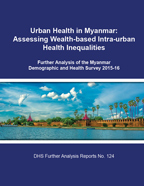- PUBLICATIONS
- JOURNAL ARTICLES
- ACCESS PUBLICATIONS
Publications Summary
- Document Type
- Further Analysis
- Publication Topic(s)
- Child Health and Development, Family Planning, Maternal Health, Nutrition, Wealth/Socioeconomics
- Country(s)
- Myanmar
- Survey
- Myanmar DHS, 2015-16
- Language
- English
- Recommended Citation
- Sann-Lwin, Kyawt, and Lwin Lwin Aung. 2019. Urban Health in Myanmar: Assessing Wealth-based Intraurban Health Inequalities. Further Analysis of the Myanmar Demographic and Health Survey 2015-16. DHS Further Analysis Reports No. 124. Rockville, Maryland, USA: ICF.
- Download Citation
- RIS format / Text format / Endnote format
- Publication Date
- March 2019
- Publication ID
- FA124
Download
 Urban Health in Myanmar: Assessing Wealth-based Intra-urban Health Inequalities (PDF, 733K)
Urban Health in Myanmar: Assessing Wealth-based Intra-urban Health Inequalities (PDF, 733K)
